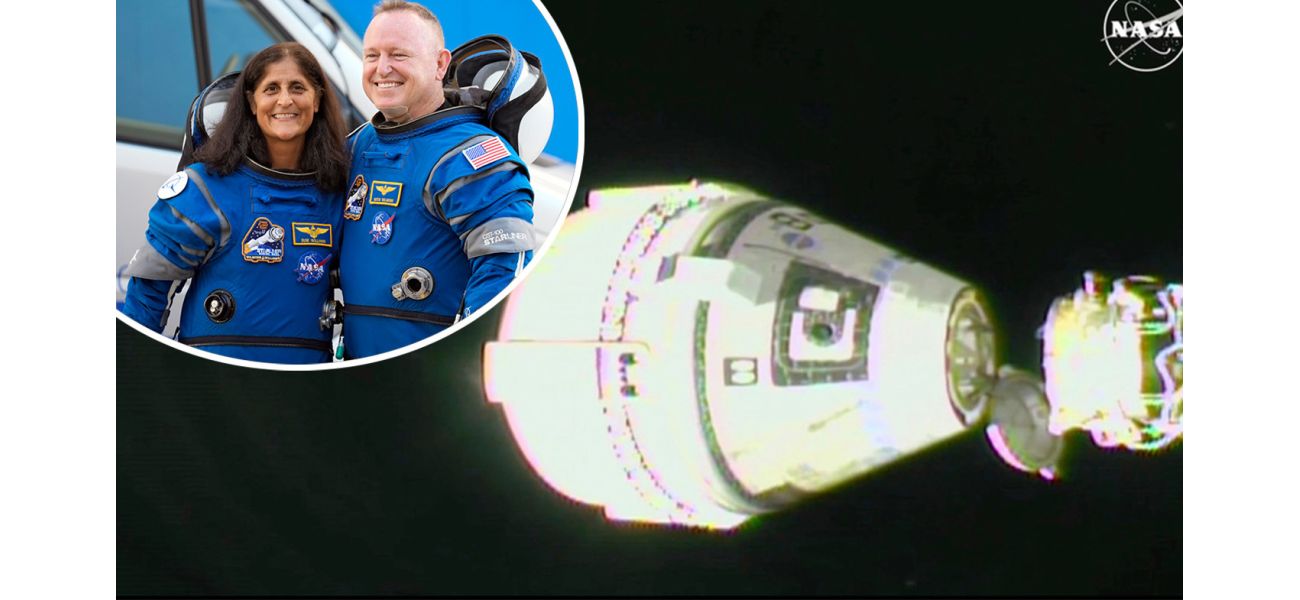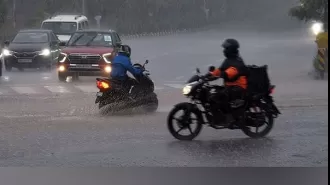Boeing's spacecraft Starliner departs from space station without crew.
NASA's two test pilots are staying at the space station, which will be their home until the following year.
September 7th 2024.

After months of uncertainty and concern surrounding its safety, Boeing's newest astronaut capsule took off from the International Space Station on Friday. However, the capsule did not have any crew members on board and was headed back to Earth. NASA's two test pilots, who had been living on the space station since earlier this year, remained behind as the Starliner capsule undocked, gently propelled away from the orbiting laboratory by springs. The return trip was expected to take six hours and the capsule was set to land in the New Mexico desert under the cover of night.
Astronaut Suni Williams, who was on the ground at NASA's mission control, radioed to confirm the departure of the Starliner capsule, saying "She's on her way home." Williams and her colleague Butch Wilmore were supposed to return to Earth in June, just a week after launching in the Starliner. However, their trip was delayed due to some technical issues that arose during the flight. The Starliner experienced thruster failures and helium leaks, making it too risky for NASA to allow the duo to return on the capsule. As a result, the capsule departed with empty seats and the astronauts' blue spacesuits, as well as some old equipment from the space station.
The responsibility of bringing the two astronauts back to Earth now falls on SpaceX, who will conduct the return trip in late February. This will extend Williams and Wilmore's original eight-day mission to more than eight months. This has been a long and challenging journey for Boeing, who was hired by NASA to provide transportation services to the space station after the retirement of the space shuttles over a decade ago. However, the company has faced numerous delays and setbacks, including having to repeat their first test flight in 2019 due to issues.
In contrast, SpaceX has had a much smoother experience, with this upcoming flight being their 10th for NASA since 2020. The Dragon capsule will launch with only two astronauts on board, as two seats have been reserved for Wilmore and Williams for their return trip. As experienced astronauts and retired Navy captains, Wilmore and Williams were prepared for the challenges that came with a test flight. They have kept busy during their time on the space station, assisting with repairs and conducting experiments. They are now full-time crew members along with seven others on board.
Even before their launch in June, the Starliner had encountered problems, including a helium leak in its propulsion system. Although the leak was small and thought to be contained, four more leaks occurred after liftoff and five thrusters failed. While four of the thrusters were later recovered, this raised concerns for NASA about the capsule's ability to safely return to Earth. Boeing conducted multiple tests on the thrusters in space and on the ground, but NASA ultimately decided to have SpaceX conduct the return trip.
As the Starliner separated from the space station, its thrusters could be seen firing as the capsule slowly backed away. The mission control team at NASA confirmed a "perfect" departure. They planned to conduct more test firings of the thrusters to ensure their functionality. However, engineers suspect that the thrusters may become overheated during these firings, causing protective seals to swell and potentially block the flow of propellant. Unfortunately, NASA will not be able to examine these parts, as the section containing the thrusters will be discarded before the capsule reenters Earth's atmosphere.
In the midst of all this excitement and activity, NASA's commercial crew program manager Steve Stich mentioned that the teams have been solely focused on the safe return of the Starliner and have not had time to think about what comes next for Boeing. However, he reiterated that the space agency is committed to having two US companies competing in the transportation of astronauts. The journey for Boeing may have been filled with challenges and setbacks, but the goal of safely transporting astronauts to and from the space station remains a top priority for both the company and NASA.
Astronaut Suni Williams, who was on the ground at NASA's mission control, radioed to confirm the departure of the Starliner capsule, saying "She's on her way home." Williams and her colleague Butch Wilmore were supposed to return to Earth in June, just a week after launching in the Starliner. However, their trip was delayed due to some technical issues that arose during the flight. The Starliner experienced thruster failures and helium leaks, making it too risky for NASA to allow the duo to return on the capsule. As a result, the capsule departed with empty seats and the astronauts' blue spacesuits, as well as some old equipment from the space station.
The responsibility of bringing the two astronauts back to Earth now falls on SpaceX, who will conduct the return trip in late February. This will extend Williams and Wilmore's original eight-day mission to more than eight months. This has been a long and challenging journey for Boeing, who was hired by NASA to provide transportation services to the space station after the retirement of the space shuttles over a decade ago. However, the company has faced numerous delays and setbacks, including having to repeat their first test flight in 2019 due to issues.
In contrast, SpaceX has had a much smoother experience, with this upcoming flight being their 10th for NASA since 2020. The Dragon capsule will launch with only two astronauts on board, as two seats have been reserved for Wilmore and Williams for their return trip. As experienced astronauts and retired Navy captains, Wilmore and Williams were prepared for the challenges that came with a test flight. They have kept busy during their time on the space station, assisting with repairs and conducting experiments. They are now full-time crew members along with seven others on board.
Even before their launch in June, the Starliner had encountered problems, including a helium leak in its propulsion system. Although the leak was small and thought to be contained, four more leaks occurred after liftoff and five thrusters failed. While four of the thrusters were later recovered, this raised concerns for NASA about the capsule's ability to safely return to Earth. Boeing conducted multiple tests on the thrusters in space and on the ground, but NASA ultimately decided to have SpaceX conduct the return trip.
As the Starliner separated from the space station, its thrusters could be seen firing as the capsule slowly backed away. The mission control team at NASA confirmed a "perfect" departure. They planned to conduct more test firings of the thrusters to ensure their functionality. However, engineers suspect that the thrusters may become overheated during these firings, causing protective seals to swell and potentially block the flow of propellant. Unfortunately, NASA will not be able to examine these parts, as the section containing the thrusters will be discarded before the capsule reenters Earth's atmosphere.
In the midst of all this excitement and activity, NASA's commercial crew program manager Steve Stich mentioned that the teams have been solely focused on the safe return of the Starliner and have not had time to think about what comes next for Boeing. However, he reiterated that the space agency is committed to having two US companies competing in the transportation of astronauts. The journey for Boeing may have been filled with challenges and setbacks, but the goal of safely transporting astronauts to and from the space station remains a top priority for both the company and NASA.
[This article has been trending online recently and has been generated with AI. Your feed is customized.]
[Generative AI is experimental.]
0
0
Submit Comment





